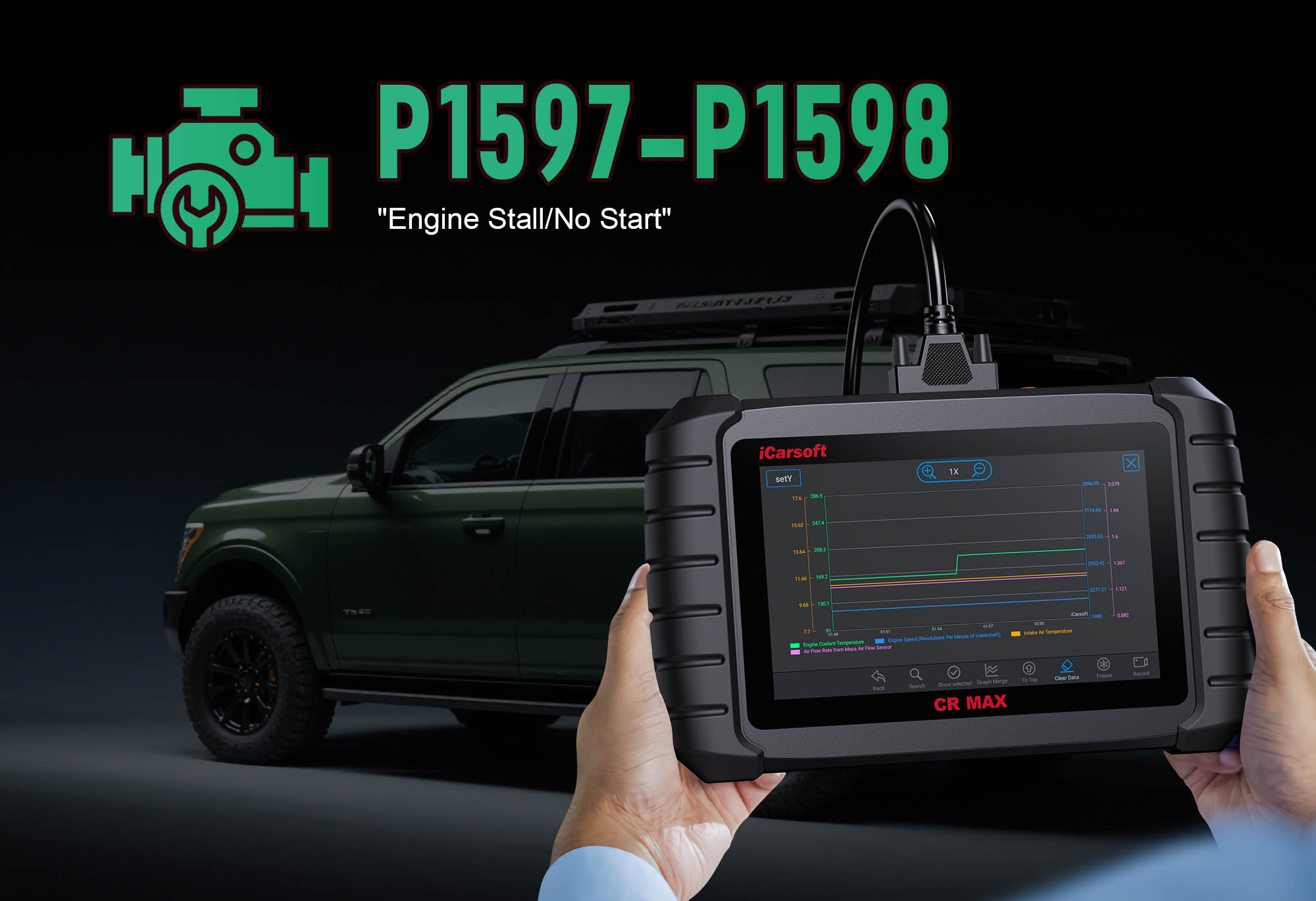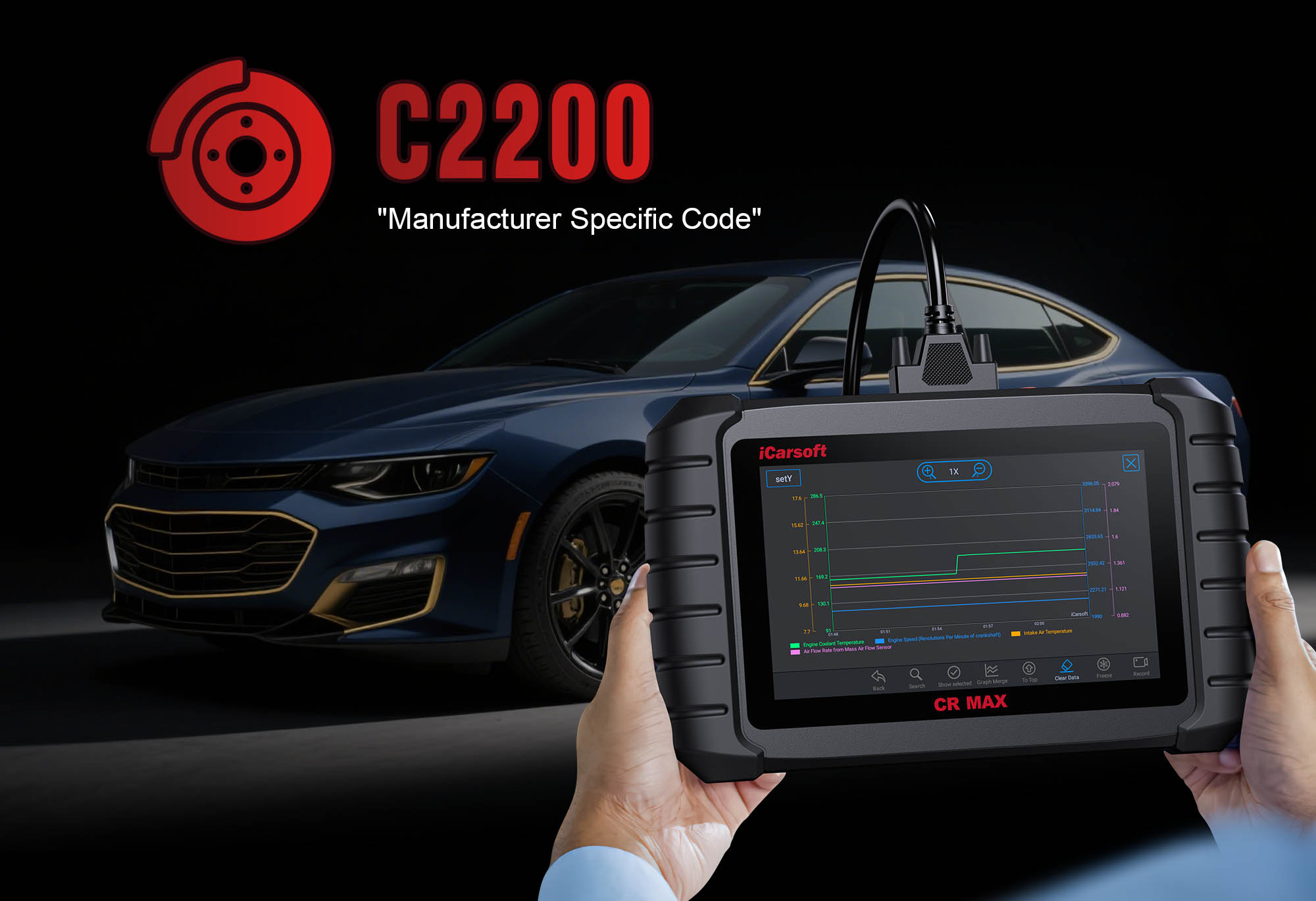How to Diagnose & Clear P1597-P1598 with iCarsoft CR MAX BT: Fix Idle Air Control System Faults
If your check engine light illuminates and a scan pulls P1597 or P1598, you’re dealing with issues in your vehicle’s Idle Air Control (IAC) system—critical for maintaining stable idle speed when the throttle is closed (e.g., at stoplights). These manufacturer-specific codes (most common in FCA Group vehicles like Chrysler, Jeep, Dodge, and Ram) typically translate to distinct circuit faults that disrupt idle performance.
Key Code Definitions for FCA Vehicles:
- P1597: “Idle Air Control (IAC) System Circuit Low” — The ECM detects voltage below the acceptable range in the IAC circuit, often leading to low or unstable idle.
- P1598: “Idle Air Control (IAC) System Circuit High” — The ECM detects voltage above the acceptable range, usually causing high or erratic idle.
Left unaddressed, P1597-P1598 cause frustrating symptoms: erratic idle (spiking from 500 to 1,200 RPM), stalling when stopping, high idle that won’t lower, or even difficulty starting. Basic scanners might only confirm “IAC fault” but fail to distinguish between a dirty IAC valve, broken wiring, or faulty ECM. The iCarsoft CR MAX BT—a wireless, multi-brand diagnostic tool—changes this by turning vague “idle issues” into actionable repairs.
First: Understand P1597-P1598—What They Mean & Why They Happen
Before diving into diagnostics, clarify the basics to avoid missteps. The IAC system is the backbone of stable idle, and its failure triggers P1597-P1598 for specific, traceable reasons.
The IAC System’s Role
The Idle Air Control Valve (IACV) regulates airflow into the engine when the throttle is closed. It works in tandem with the ECM to adjust idle speed (typically 600–900 RPM for gasoline engines). For example:
-
When you turn on the AC (adding engine load), the IACV opens slightly to raise idle and prevent stalling.
-
During cold starts, the IACV opens wider to increase airflow, helping the engine warm up faster.
-
When electrical loads (e.g., headlights, radio) are active, the IACV adjusts to maintain consistent RPM.
Key Symptoms of P1597-P1598
Erratic Idle Speed
RPM fluctuates wildly—e.g., drops to 400 RPM (nearly stalling) then jumps to 1,000 RPM—even when the engine is warm. This is the most common and noticeable symptom.
Engine Stalling at Stops
When coming to a stop (throttle closed), the engine stalls entirely. This happens because the IACV can’t supply enough airflow to keep the engine running at idle.
Persistent High Idle
Idle speed stays at 1,200+ RPM even after the engine warms up. This indicates the IACV is stuck open (common with P1598) or receiving incorrect voltage from the ECM.
Difficulty Starting
The engine cranks longer than usual or fails to start on the first try. The IACV can’t adjust airflow for cold starts, leading to a lean or rich fuel mixture.
Common Causes of P1597-P1598
Dirty/Clogged IAC Valve
Carbon buildup from fuel and oil residues blocks airflow, causing the valve to stick or send incorrect position signals to the ECM. This is the #1 cause for FCA vehicles with high mileage.
Faulty IAC Valve
Internal electrical failure (e.g., broken coil or sensor) leads to low/high circuit voltage. For P1597, the valve may have an open circuit; for P1598, a short circuit.
Damaged Wiring/Connectors
Frayed wires, corroded pins, or loose connectors in the IAC circuit disrupt voltage flow. P1597 often points to an open circuit (no power), while P1598 signals a short circuit (excess power).
Clogged Throttle Body
A dirty throttle plate restricts overall airflow, forcing the IACV to overcompensate. This creates a feedback loop that triggers P1597-P1598, even if the IACV itself is functional.
ECM Malfunction (Rare)
The ECM’s IAC driver circuit fails, unable to send proper voltage to the valve. This is only likely after ruling out all other causes (e.g., wiring, valve, throttle body).
Why iCarsoft CR MAX BT Is Perfect for P1597-P1598
P1597-P1598 require IAC-specific testing—an area where the CR MAX BT outperforms basic tools, leveraging its unique features tailored for FCA Group vehicles and idle air control systems.
Step-by-Step: Diagnose P1597-P1598 with iCarsoft CR MAX BT
Follow this structured process to pinpoint the root cause of P1597-P1598 and fix it permanently. The CR MAX BT eliminates guesswork at every stage.
-
1. Connect the CR MAX BT & Confirm the Codes
-
Plug the CR MAX BT’s OBD-II adapter into your vehicle’s port (under the dashboard), then power on the tool. Pair it with the adapter via Bluetooth using the tool’s on-screen pairing guide (takes 30 seconds).
-
Select Vehicle Make > FCA Group (Chrysler/Jeep/Dodge/Ram), then use Auto VIN Identify to auto-detect your model/year (e.g., 2019 Dodge Charger 3.6L). This ensures you get FCA-specific data.
-
Navigate to Engine > Fault Codes > Read Codes to confirm P1597, P1598, or related codes (e.g., P0505 for “Idle Air Control System Malfunction”). Tap Code Details to view FCA-specific triggers (e.g., “Jeep Grand Cherokee: IAC Circuit Voltage >4.7V for 10 seconds”).
-
2. Analyze Real-Time IAC Data
-
Go to Engine > Live Data > Idle Control and select these 4 critical parameters (use the tool’s “Add to Favorites” to track them side-by-side):
-
“IAC Valve Position” (percentage open—normal: 10%–30% at warm idle)
-
“IAC Circuit Voltage” (should match FCA specs: 0.5V–4.5V)
-
“Target Idle Speed” (ECM’s desired RPM)
-
“Actual Idle Speed” (engine’s real RPM)
-
Start the engine and let it warm up to operating temperature (10–15 minutes, until coolant temp reaches 180°F). Do not rev the engine during warm-up—this skews data.
-
Compare the data to spot issues:
-
P1597 Clue: IAC voltage <0.5V + Actual idle < Target idle (open circuit—no power to valve).
-
P1598 Clue: IAC voltage >4.5V + Actual idle > Target idle (short circuit—valve stuck open).
-
Both Codes: IAC position fluctuates randomly + idle speed jumps (dirty or faulty valve).
-
3. Test the IAC Valve with Bi-Directional Control
-
Navigate to Special Functions > Engine > Idle Control > IAC Actuation Test. This step confirms if the IACV is functional—critical for ruling out a faulty valve.
-
Follow on-screen prompts: Turn the ignition to “On” (engine off) for safety, then select Test IAC Valve. The tool will send incremental commands to adjust the valve position (e.g., 20% → 50% → 80%).
-
Interpret the response:
-
Normal Response: Faint “clicking” from the IACV (located on the throttle body) + “IAC Position Feedback” matches the command (e.g., 50% command = 50% feedback). Valve is working.
-
No Response: No clicking + feedback doesn’t match command. Either the IACV is faulty (replace it) or no power reaches it (check wiring—Step 4).
-
Erratic Response: Clicking is inconsistent + feedback jumps randomly. IACV is dirty (clean with throttle body cleaner) or has internal wear.
-
4. Inspect IAC Wiring & Connectors
-
Step 1: Locate the IACV — Use the CR MAX BT’s Component Location tool (found under “Service Data”) to find the valve. It’s typically mounted on the throttle body, connected to a 2–4 pin connector.
-
Step 2: Disconnect the IACV Connector — Inspect the pins for corrosion, bending, or damage. Clean corroded pins with electrical contact cleaner (avoid water-based cleaners).
-
Step 3: Test Circuit with CR MAX BT’s Multimeter (no separate tool needed!):
-
Voltage Test (for P1597): Set to “DC Voltage.” Connect one probe to the connector’s “Power” pin (refer to CR MAX BT’s wiring diagram) and the other to ground. Turn ignition to “On”—should read ~12V (from the ECM). No voltage = broken wire or blown fuse.
-
Resistance Test (for P1598): Set to “Ohms.” Connect probes to the IACV’s two pins (not the vehicle’s connector). Normal resistance: 10–30 ohms (FCA specs). Resistance <5 ohms = short-circuited IACV (replace it).
-
Step 4: Check the IAC Fuse — Use the CR MAX BT’s Fuse Location feature to find the “IAC/Throttle” fuse (usually in the engine bay fuse box). Replace if blown (match amperage: 7.5A–10A per FCA specs).
-
5. Clean/Replace the IACV & Throttle Body
-
If IACV is Dirty:
-
Remove the IACV (follow the CR MAX BT’s “Removal Guide” for your vehicle—includes torque specs and bolt locations).
-
Clean it with throttle body cleaner (use FCA-recommended products—avoid carburetor cleaner, which damages plastic components).
-
Reinstall and torque to specs (e.g., 8 ft-lbs for Dodge Challenger).
-
If IACV is Faulty:
-
Use the CR MAX BT’s Part Lookup to find the OEM replacement (e.g., Mopar 68210576AA for 2021 Ram 1500).
-
Replace the valve, then reconnect the connector—ensure pins are fully seated.
-
If Throttle Body is Dirty:
-
Use the CR MAX BT’s Throttle Body Cleaning Guide to remove and clean the throttle plate. A dirty plate worsens IAC issues by restricting baseline airflow—critical for FCA vehicles.
-
6. Clear Codes & Relearn Idle Parameters
-
Step 1: Clear the Codes — Go to Fault Codes > Clear Codes and select P1597/P1598. Confirm deletion—do not skip this (old codes may interfere with relearn).
-
Step 2: Run Engine Idle Service (mandatory for FCA vehicles):
-
Navigate to Special Functions > Engine > Idle Control > Idle Relearn.
-
Follow prompts: Start the engine, let it idle for 2 minutes, then rev to 2,000 RPM 3 times (the tool monitors and stores new idle parameters in the ECM).
-
Step 3: Verify Repairs:
-
Idle the engine for 10 minutes—check for smooth operation (no fluctuations).
-
Take a 20-mile test drive (include stop-and-go city driving). Use the CR MAX BT’s Data Logging to record IAC data for later review.
-
Re-scan after the drive:
-
No P1597/P1598 + Actual idle = Target idle: Fix is successful.
-
Codes return: Double-check for hidden wiring issues or a failing ECM (use the CR MAX BT’s ECM Health Check to confirm).
Pro Tip for FCA Owners: Some 2018+ Jeep Wrangler and Ram 1500 models require a “throttle body alignment” after cleaning. The CR MAX BT includes this function under Special Functions > Engine > Throttle Body > Alignment—skip it, and idle issues will persist even after IACV repair.
How to Prevent P1597-P1598 from Recurring
The CR MAX BT helps keep your IAC system healthy long-term, avoiding future P1597-P1598 codes with proactive maintenance.
-
1. Quarterly IAC Checks
-
Use the CR MAX BT’s Idle Control Health Scan (under “Quick Tests”) to monitor IAC position and voltage. Set reminders via the tool’s “Service Schedule” feature.
-
Look for early warning signs: IAC position >35% at warm idle (indicates carbon buildup) or voltage outside 0.5V–4.5V (signals wiring issues).
-
2. Clean IACV/Throttle Body Annually
-
Follow the CR MAX BT’s maintenance reminders—annual cleaning reduces carbon buildup, the #1 cause of P1597-P1598. The tool’s “Cleaning Timer” tracks mileage since last service.
-
Use FCA-approved throttle body cleaner (listed in the CR MAX BT’s “Product Recommendations”) to avoid damaging plastic or rubber components.
-
3. Use Top-Tier Fuel & Monitor Battery Voltage
-
Top-tier fuels (e.g., Chevron, Shell) contain more detergents, reducing carbon buildup in the IACV and throttle body.
-
Test battery voltage monthly via the CR MAX BT’s Battery Voltage Test. A weak battery (<12.4V when off) causes erratic IAC signals—replace batteries older than 3 years.
-
4. Update ECM Software
-
Use the CR MAX BT’s One-Key Upgrade (lifetime free) to install FCA’s latest ECM patches. Some P1597-P1598 cases are software-related—updates fix voltage threshold calibrations.
-
Check for updates every 3 months (the tool alerts you to new software).
FAQ: Common Questions About P1597-P1598
Q: Will P1597-P1598 damage my engine if I keep driving?
A: Not immediately, but prolonged driving with these codes increases risk: Erratic idle can cause premature wear on engine mounts (from vibration), and stalling poses a safety hazard (e.g., at intersections). High idle also wastes fuel and strains the alternator. Fix the issue within 1–2 weeks of seeing the check engine light.
Q: Can I clean the IACV myself, or do I need a mechanic?
A: You can clean it yourself with the CR MAX BT’s guidance! The tool provides step-by-step removal/cleaning instructions for your specific FCA model, including torque specs and safety warnings. All you need is throttle body cleaner, a soft brush, and 30–45 minutes. Mechanics typically charge $150–$200 for this service—DIY saves money.
Q: Why do P1597-P1598 keep coming back after I clear them?
A: The most common reason is skipping the
idle relearn (critical for FCA vehicles) or incomplete repairs:
-
You cleaned the IACV but not the throttle body—carbon buildup there still forces the IACV to overcompensate.
-
Wiring issues (e.g., a frayed wire) were not fully repaired—intermittent contact triggers the code again.
-
The ECM needs a software update—old calibrations misread IAC voltage.
Use the CR MAX BT’s
Data Logging to capture when the code returns (e.g., “After AC is turned on”)—this narrows down the root cause.
Q: Does the CR MAX BT work for P1597-P1598 on non-FCA vehicles?
A: Yes! While P1597-P1598 are most common in FCA Group vehicles, they also appear in other makes (e.g., Ford, GM, Hyundai) with IAC systems. The CR MAX BT supports IAC diagnostics for over 40 brands, including make-specific data (e.g., Ford’s IAC voltage range: 0.6V–4.4V) and bi-directional testing. Simply select the correct vehicle make during setup.
Summary Table: P1597-P1598 Diagnosis & Repair Steps
|
Step
|
Action with iCarsoft CR MAX BT
|
Common Fix
|
|
1
|
Scan Engine system; confirm P1597/P1598 + check related codes
|
Identify IAC circuit fault type (low/high voltage)
|
|
2
|
Monitor real-time IAC data (position, voltage, target/actual idle)
|
Pinpoint if issue is valve, wiring, or ECM-related
|
|
3
|
Run bi-directional IAC actuation test
|
Clean (erratic response) or replace (no response) IACV
|
|
4
|
Test wiring/connectors with built-in multimeter; check IAC fuse
|
Repair corroded wires or replace blown fuse
|
|
5
|
Clear codes; run idle relearn + throttle body alignment (FCA)
|
Sync IAC system with ECM
|
|
6
|
Log data during test drive; re-scan to confirm no codes
|
Verify stable idle (actual = target RPM)
|
Final Thoughts
P1597-P1598’s “idle air control” label can be misleading—what seems like a faulty valve might be a simple wiring fix or dirty throttle body. The iCarsoft CR MAX BT cuts through the guesswork with its wireless convenience, FCA-specific data, and IAC-focused tools, turning a frustrating “idle problem” into a straightforward repair.
Whether you’re a DIYer with a Jeep Wrangler or a technician working on a Dodge Charger, the CR MAX BT empowers you to: diagnose the real cause (not just the code), avoid unnecessary part replacements, and verify repairs with confidence. It’s not just a scanner—it’s a solution for keeping your FCA vehicle’s idle smooth and reliable.
Don’t let erratic idle or stalling ruin your drive. With the CR MAX BT and this guide, you’ll resolve P1597-P1598 quickly—and keep your vehicle running at its best for miles to come.





